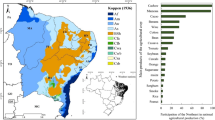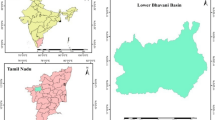Abstract
Based on the AVHRR pathfinder remote sensing data, soil moisture, precipitation and evaporation during the period of 1982–1998, soil moisture of all layers of soil-profile (0–1 m) in the Yellow River basin over the 17 years are calculated by the remote sensing model of calculating soil water. The Yellow River basin is divided into seven subcatchments as control sections at the location of six hydrologic stations (Lanzhou, Toudaoguai, Longmen, Sanmenxia, Huayuankou and Lijin). After calculating soil moisture and obtaining runoff data and precipitation data, the dynamical features of hydrological cycle in the Yellow River basin are analyzed for the period from 1982 to 1988 using water balance method. The conclusions are as follows: It is feasible to calculate the soil water on the macro-scale, in the soil profile with temporal continuity by means of remote sensing and survey in land. Some values of the key water cycle factors in the Yellow River are obtained, which include the annual precipitation of 4000 km3, the evapotranspiration of 3000–3500 km3, and the soil moisture transformation of −500–500 km3. Consequently, we analyzed the process of the water cycle in the Yellow River over the 17 years, and the results show that the segment upstream of Lanzhou city is a relatively humid region, and the area of internal waters and the reaches of Shanshan is the most desiccated region. Therefore, the runoff in the depth process is intensive and the runoff-generating process is weak in more arid regions.
Similar content being viewed by others
References
Lin Chang-ming, Sun Rui, Ecological aspects of water cycle: advances in soil-vegetation-atmosphere of energy and water fluxes, Advances in Water Science (in Chinese), 1999, 10(3): 251–259.
Li Bao-guo, Gong Yuan-you, Zuo Qiang, The Model of Soil Water Movement in Farmland and Its Application (in Chinese), Beijing: Sciences Press, 2000.
Lei Zhidong, Hu Heping, Yang Shixin, The progress on soil water research, Advances in Water Science (in Chinese), 1999, 10(3): 211–214.
Chen Huailiang, Mao Linxi, Feng Dingyuan, A review: Theories, methods and development on soil moisture monitoring by remote seming, Remote Sensing Technology and Application (in Chinese), 1999, 14(2): 55–65.
Shen Guangrong, Tian Guoliang, Drought monitoring with crop water stress index. Agricultural Research in the Arid Areas (in Chinese), 1998, 16(1): 123–128.
Zhang Renhua, Sun Xiaomin, Liu Jiyuan et al., Determination of regional distribution of crop transpiration and soil water use efficiency using quantitative remote sering data through inversion, Science in China (Series D), 2003, 46(1): 10–22.
Zhang Renhua, Su Hongbo, Li Zhaoliang et al., The potential information in the temperature difference between shadow and sunlit of surfaces and a new way of retrieving the soil moisture, Science in China (Series D), 2001, 44(2): 112–123.
Guo Jianping, Gao Shuhua, Wan Jianhua et al., The Resources of Meteorological Water and Soil Water in China (in Chinese), Beijing: The Meteorological Press, 2001.
Kogan, F. N., Remote sensing of weather impacts on vegetation in non-homogeneous areas. Int. J. of Remote Sensing, 1990, 11: 1405–1420.
Kogan, F. N., Application of vegetation index and brightness temperature for drought detection, Advances in Space Research, 1995, 15: 91–100.
Chen Weiying, Xiao Qianguang, Sheng Yongwei, Application of anomaly vegetation index to monitoring heavy drought in 1992, Remote Sensing of Environment (in Chinese), 1994, 9(2): 106–112.
Gillies, R. R., Carlson, T. N., Cui, J. et al., A verification of the ‘triangle’ method for obtaining surface soil water content and energy fluxes from remote measurement of the Normalized Difference Vegetation Index (NDVI) and surface radiant temperature, International Journal of Remote Sensing, 1997, 18: 3145–3166.
Wang, P.-X., Li, X.-W., Gong, J.-Y. et al., Vegetation temperature condition index and its application for drought monitoring, Proceedings of IGARSS 2001 International Geoscience and Remote Sensing Symposium, July 9–14, 2001 (Sydney, Australia).
Wang Pengxin, Gorg Jianya, Li Xiaowen, Vegetation-temperature condition index and its application for drought monitoring, Geometrics and Information Science of Wuhan University (in Chinese), 2001, 26(5): 412–418.
Yang Shengtian, Liu Changming, Wang Pengxing, The method of calculating soil water in Yellow River basin by remote senring, Progress in Geography (in Chinese), 2003, 22(5): 454–462.
Author information
Authors and Affiliations
Corresponding author
Rights and permissions
About this article
Cite this article
Yang, S., Liu, C. Calculating soil moisture by remote sensing and analyzing hydrologic cycle process in the Yellow River basin. Sci. China Ser. E-Technol. Sci. 47 (Suppl 1), 1–13 (2004). https://doi.org/10.1360/04ez0001
Received:
Issue Date:
DOI: https://doi.org/10.1360/04ez0001




